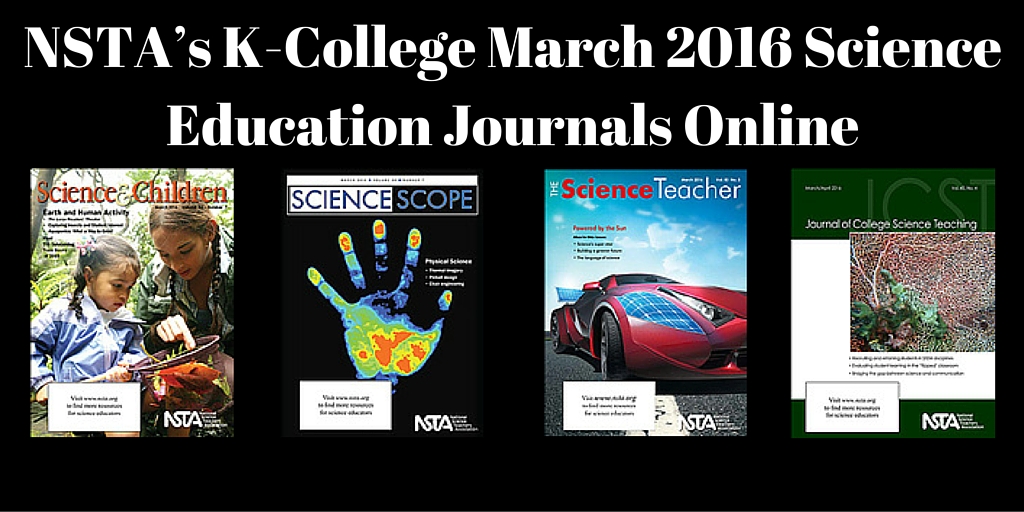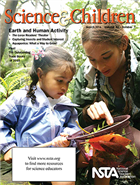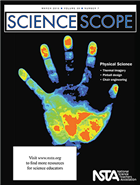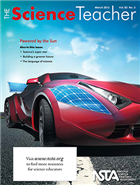NSTA’s K-College March 2016 Science Education Journals Online
By Korei Martin
Posted on 2016-03-01
Looking to show your students the connections between plants, animals, and the environment? Want in-depth activities to explain physical science concepts to your middle school students? Are your students interested in how solar energy works? Are you curious about connecting intermolecular forces to real world phenomena using a concept-building activity? The March K–College journals from the National Science Teachers Association (NSTA) have the answers you need. Written by science teachers for science teachers, these peer-reviewed journals are targeted to your teaching level and are packed with lesson plans, expert advice, and ideas for using whatever time/space you have available. Browse the March issues; they are online (see below), in members’ mailboxes, and ready to inspire teachers!
It may be hard to see on first glance, but examples of human impacts on Earth are all around us. Through the activities in this issue, students will learn about ecology while gaining a deeper connection to plants, animals, and the environment.
Featured articles (please note, only those marked “free” are available to nonmembers without a fee):
- Aquaponics: What a Way to Grow!
- Capturing Insects and Student Interest
- Crabby Interactions
- Understanding Human Impact
- Free – Outstanding Science Trade Books for Students K–12
- Free – The Lorax Readers’ Theater
- Table of Contents
Seeing is believing—and it can also lead to understanding, as is the case when you use a thermal imaging camera to explore the concept of the conservation of energy. This is just one of the hands-on activities you’ll find in this issue that will help you explain physical science concepts to your middle level students.
Featured articles (please note, only those marked “free” are available to nonmembers without a fee):
- Build Your Own Sunglasses
- Chemical Connections: A Problem-Based Learning, STEM Experience
- Free – Editor’s Roundtable: Spreading the News—With Care!
- Exposing Hidden Energy Transfer With Inexpensive Thermal Imaging Cameras
- Outstanding Science Trade Books for Students K–12
- Free – What We Call Misconceptions May Be Necessary Stepping-Stones Toward Making Sense of the World
- Table of Contents
Solar energy is clean, free, and abundant worldwide. The challenge, however, is to convert it to useful forms that can reduce our reliance on fossil fuels. In this issue, the feature article “Powered by the Sun” presents an activity in which students learn firsthand how solar energy can be used to produce electricity specifically for transportation. The activity introduces students to solar-powered mass transit and challenges them to design their own solar vehicle. “Building a Greener Future,” another article using the engineering-design process, describes how students designed and built compost bins for a community garden. This issue also addresses partition coefficients in chemistry, using the starlet sea anemone in biological research, and the challenges posed by the language of science texts—and how to overcome them.
Featured articles (please note, only those marked “free” are available to nonmembers without a fee):
- Building a Greener Future
- Does It Mix?
- Free – Editor’s Corner: Write for the Science Teacher (part 2)
- Outstanding Science Trade Books for Students K–12
- Free– Powered by the Sun
- Science’s Super Star
- Table of Contents
Journal Of College Science Teaching 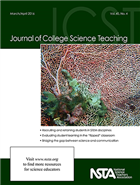
Read about a study that focused on connecting the abstract science concept of intermolecular forces to real-world phenomena using a concept-building activity. See the Research and Teaching article that examined the effect of a 6-week summer bridge program on STEM retention of targeted demographic groups. And be sure to read the Two-Year Community column article about an online Introduction Biology course desig
ned to follow the recommendations from the Vision and Change in Undergraduate Biology Education: A Call to Action report.
Featured articles (please note, only those marked “free” are available to nonmembers without a fee):
- Free – A Hands-On Activity to Build Mastery of Intermolecular Forces and Its Impacts on Student Learning
- An Interdisciplinary Approach to Success for Underrepresented Students in STEM
- Deliberative Pedagogy in a Nonmajors Biology Course: Active Learning That Promotes Student Engagement With Science Policy and Research
- Developing Student Presentation Skills in an Introductory-Level Chemistry Course With Audio Technology
- Research and Teaching: Association of Summer Bridge Program Outcomes With STEM Retention of Targeted Demographic Groups
- Research and Teaching: Undergraduate Science Students’ Attitudes Toward and Approaches to Scientific Reading and Writing
- Table of Contents
Get these journals in your mailbox as well as your inbox—become an NSTA member!
The mission of NSTA is to promote excellence and innovation in science teaching and learning for all.
Follow NSTA
Disclaimer: The views expressed in this blog post are those of the author(s) and do not necessarily reflect the official position of the National Science Teaching Association (NSTA).



